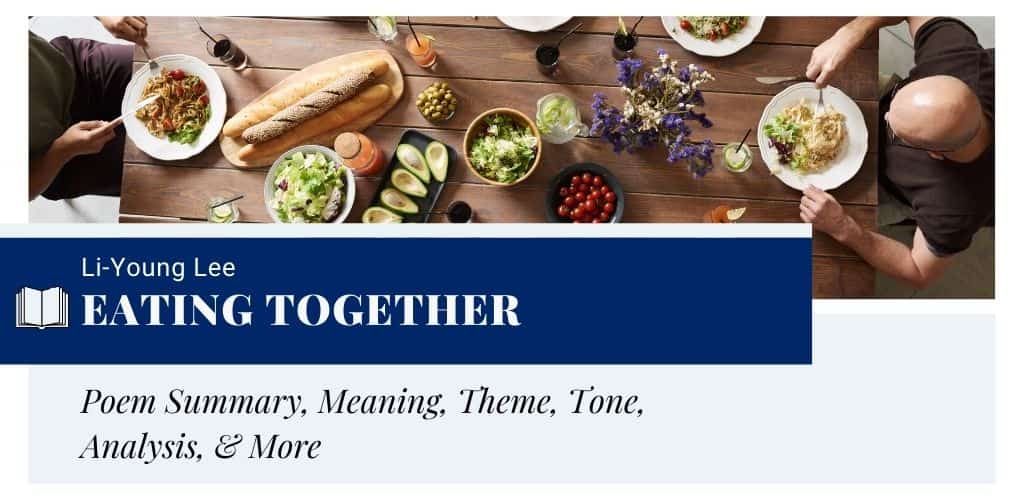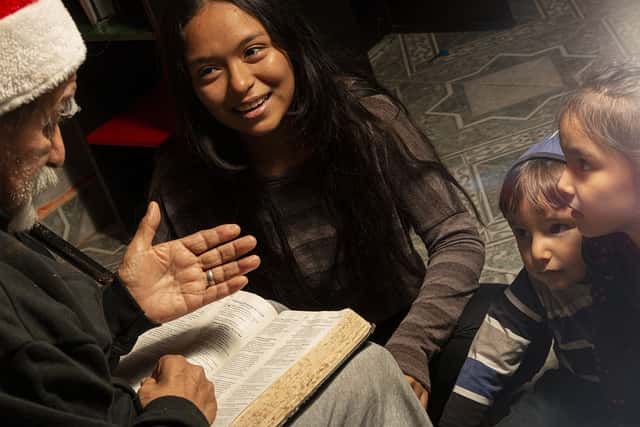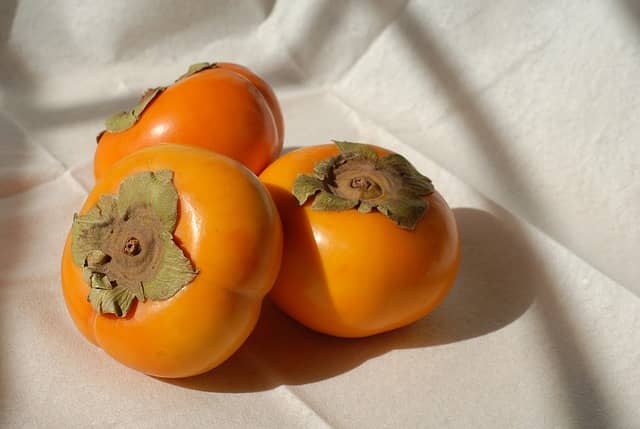Eating Together by Li-Young Lee
“Eating Together” is written by Asian-American poet Li-Young Lee. It appears in his poetry collection Rose (1986). This piece centers on the themes of family tradition, death, and relationship. The speaker of this poem shares one of his memories of lunch with his family. After describing the scene, he becomes sad about his father’s death. He can remember those days when his father sat with other family members and tasted the “sweetest meat” of the piece with his wife.
- Read the full text of “Eating Together” below:
Eating Together by Li-Young Lee In the steamer is the trout seasoned with slivers of ginger, two sprigs of green onion, and sesame oil. We shall eat it with rice for lunch, brothers, sister, my mother who will taste the sweetest meat of the head, holding it between her fingers deftly, the way my father did weeks ago. Then he lay down to sleep like a snow-covered road winding through pines older than him, without any travelers, and lonely for no one. - from Rose (1986)

Summary
“Eating Together” begins with a description of how the lunch was prepared. They put the trout in the steamer and seasoned it with ginger, sprigs of green onion, and sesame oil. Then they sat together to have the fish with rice. The speaker has some brothers and a sister. When they sat for lunch, his mother was the first member to taste the sweetest meat of the trout’s head. His mother held the piece as his father did weeks ago. Then he laid down in his grave like a lonely, snow-covered road winding through pines older than him.
Meaning
Lee’s poem explores the significance of tradition and relationship. Lee’s poetic persona describes it by alluding to the way they had lunch together and then mentioning his father’s death. The overall poem means how a tradition knits each member of the family together by an invisible thread. It is the thread of love, respect, and understanding. After reading the last few lines, it becomes clear that Lee mentions the family tradition in order to portray the irrevocable loss in his family. After his father’s death, the tradition still continues but his place remains vacant forever.
Structure & Form
Lee’s “Eating Together” is a short, twelve-line poem packed into a single stanza. It is written in free-verse, meaning it does not have a specific rhyme scheme or metrical pattern. The poet uses repetitions of similar sounds in a line to create internal rhyming. For example, in the first two lines, the “s” sound is repeated to create an internal rhyming. This piece is told from the perspective of a first-person speaker. So, it is an example of a lyric poem as well. It is important to note here that the poet uses the plural point of view (“we”) in place of a singular one. This scheme posits the fact that all the family members felt the same after losing their loved one.
Literary Devices & Figurative Language
Li-Young Lee uses the following literary devices in his poem “Eating Together”:
Alliteration
The repetition of the similar sound at the beginning of neighboring words can be found in the following phrases:
- “seasoned with silvers”
- “my mother”
- “head,/ holding”
Enjambment
It occurs throughout the poem. For example, the first three lines are enjambed in order to depict how the lunch is prepared:
In the steamer is the trout
seasoned with slivers of ginger,
two sprigs of green onion, and sesame oil.
Simile
Readers can find the use of simile in:
- “to sleep like a snow-covered road”
- “winding through pines older than him”
In the first example, the speaker’s dead father is compared to a lonely road and in the second one, there is a comparison between his father’s age and that of the pines.
Asyndeton
It occurs in “brothers, sister, my mother who will”. In this line, Lee excludes conjunction to maintain the flow.
Insinuation
The speaker insinuates his father’s death in the following lines:
Then he lay down
to sleep like a snow-covered road
Line-by-Line Analysis & Explanation
Lines 1-3
In the steamer is the trout
seasoned with slivers of ginger,
two sprigs of green onion, and sesame oil.
The poem “Eating Together” begins directly with how the lunch is prepared in the family. Lee’s poetic persona describes step-by-step the recipe to cook homemade steamed trout. According to him, first, they put fresh trout in their steamer and left it for boiling. Then they seasoned the boiled, soft fish with ginger, two sprigs of green onion, and sesame oil. This vivid description of the cooking conveys the smell and overall imagery of the fish being prepared for lunch to readers.
The use of vivid colors can be found in “silvers of ginger” and “sprigs of green onion”. The first color reflects the calm and peaceful mood of the speaker while he thinks about the silvery ginger. While the image of the green sprigs is centered on the idea of vibrance and rejuvenation. Readers know that the color green is a symbol of life and associated ideas.
As the title of the poem refers to the ideas of togetherness and most importantly eating, the first three lines aptly depict the main idea of this piece.
Lines 4-8
We shall eat it with rice for lunch,
brothers, sister, my mother who will
taste the sweetest meat of the head,
holding it between her fingers
deftly,
The fourth line makes it clear that there are other members present in the scene. They are going to eat the dish with rice. Rice with seasoned fish is a traditional dish in East Asian countries such as Indonesia and Japan. From this reference, it is clear that the speaker hailed from any of these countries.
At the lunch, the speaker’s brothers, sister, and mother are present. Among them, their mother is going to taste the dish first. She will take the sweetest meat of the head and hold it between her fingers. Then she will eat it.
The speaker describes that she “deftly” holds the piece between her fingers. This specific term not only hints at how skillful she is in eating food but also refers to her experience in household works. In this way, the speaker emphasizes the role of his mother in the family.
Lines 8-12
the way my father did
weeks ago. Then he lay down
to sleep like a snow-covered road
winding through pines older than him,
without any travelers, and lonely for no one.
In the eighth line, the speaker compares the way his mother holds the piece to the holding style of his father. The similarity in their slightest movement refers to their bonding. However, he alludes to his father for a specific reason. He says, “the way my father did/ weeks ago.” It means either his father is not at home for weeks or he is no more.
The following line makes it clear that our latter inference is correct. Sadly, his father has died a few weeks ago. According to the speaker, his father laid down to sleep like a “snow-covered road”. Here, the “snow-covered road” is a symbol of death. Lee metaphorically compares his father to the “road”.
Near his father’s grave, there are pines that are older than him. By using this image, he contrasts the transience of human life with everlasting nature. The irony is the trees are older than him but they are still alive.
Lastly, the poet presents an image of a lonely road. In the region of death, one has to go alone. There are no fellow travelers to accompany a dead person. Hence, death is a lonely destination.
Theme
Li-Young Lee’s “Eating Together” explores the themes of family tradition and death. The first eight lines of the poem chiefly showcase the theme of family, tradition, and relationship. There is another idea that peeks through the content. It is the idea of eating. Through the first few lines, Lee shows how the family tradition keeps members together. There is happiness in togetherness implicit in these lines.
In the next half, the theme of death is prominent. Here, the speaker talks about the death of his father. The use of metaphors tells readers about how the poet sees death. According to him, it is a lonely “snow-covered road” without any sign of life. The theme of loss is reflected in the lines “the way my father did/ weeks ago.”
Tone & Mood
The tone of “Eating Together” is sad, contemplative, and calm. While the mood of the piece remains calm and sad throughout. In the first few lines, the speaker talks about how they sat together to have lunch. In these lines, the mood reflects a sense of satisfaction. The tone of the speaker portrays the same. This sense fades when the speaker mentions the loss in their family. The thoughts concerning his father’s death portray the sadness and loneliness of the speaker as well his family.
Historical Context
The poem “Eating Together” was originally published in Li-Young Lee’s first poetry collection Rose published in 1986. Lee was born in Jakarta, Indonesia to Chinese parents. Later they moved to Hong Kong and Japan. Finally, they settled down in the United States in 1964. Through this piece, the poet explores his family tradition of eating together. Besides, there is also a sense of loss in this poem. It is not clear whether the poet is talking about his own father. However, through this piece, he depicts how much the speaker misses his father.
Questions and Answers
“Eating Together” by Li-Young Lee is about how a speaker misses his deceased father at the time of having lunch with his family. In the first few lines, the speaker vividly describes what they have for lunch. In the following lines, he points to the absence of his father and how it makes him feel lonely. In this poem, Lee explores the father-son relationship, a recurring theme in the poems “The Gift,” “A Story,” “Persimmons,” etc., published in the volume Rose.
The last line “and lonely for no one” refers to the fact the region of death is lonely as a person cannot go there along with his loved ones. He has to go there alone. The repetition of the terms “lonely” and “no one” is used for emphasizing this idea.
The poem was originally published in 1986 in Li-Young Lee’s first poetry collection Rose.
The father in the poem died weeks ago. In this poem, the speaker refers to his father’s death in these lines: “the way my father did/ weeks ago. Then he lay down/ to sleep …”
The speaker of this piece is the poet Li-Young Lee himself.
There are the speaker’s brothers, sister, and mother in the poem. The members are having trout seasoned with ginger, sprigs of green onion, and sesame oil. They shall eat it with rice.
Similar Poems about the Father-Son Relationship
- “The Gift” by Li-Young Lee – Lee’s poem concerns how his father dexterously pulled out a metal blade from his soft, little hand in his childhood.
- “For My Father, Karachi 1947” by Meena Alexander – This poem alludes to the tragic partition story of India and Pakistan in 1947 and its impact on her father’s mind.
- “The Toys” by Coventry Patmore – This poem centers on an incident of a father rebuking his son.
- “Casabianca” by Felicia Hemans – It’s about a boy named Casabianca, who lost his life for his sheer obedience to his father.
External Resources
- The Poem Aloud — Listen to Li-Young Lee reading his poem “Eating Together.”
- Poetry and Food — Explore a list of poems about eating and cooking, and exploring our relationships with food.
- About Li-Young Lee — Learn about the poet’s life and works.
- Poet Profile & Poems of Li-Young Lee — Explore more about the poet and read some of his well-known poems.



